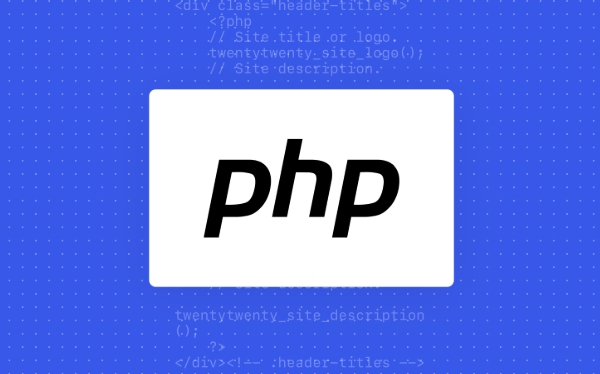 Backend Development
Backend Development
 PHP Tutorial
PHP Tutorial
 Beyond `if-else`: Exploring PHP's Alternative Control Structures
Beyond `if-else`: Exploring PHP's Alternative Control Structures
Beyond `if-else`: Exploring PHP's Alternative Control Structures
Jul 30, 2025 am 02:03 AMThe alternative control structure of PHP uses colons and keywords such as endif and endfor instead of curly braces, which can improve the readability of mixed HTML. 1. If-elseif-else starts with a colon and ends with an endif, making the condition block clearer; 2. Foreach is easier to identify in the template loop, and endforeach clearly indicates the end of the loop; 3. Although for and while are less used, they are also supported. This syntax has obvious advantages in view files: reduce syntax errors, enhance readability, and is similar to HTML tag structure. But curly braces should continue to be used in pure PHP files to avoid confusion. Therefore, alternative syntax is recommended in templates that mix PHP and HTML to improve code maintainability.

When writing PHP code, most developers default to familiar control structures like if-else , for , and while . But PHP offers an alternative syntax that's not only valid but can improve readability—especially in templates. These alternative control structures go beyond standard curly-brace syntax and are particularly useful when mixing PHP with HTML.

Let's explore how PHP's alternative control structures work and where they shine.
What Are PHP's Alternative Control Structures?
PHP supports an alternative syntax for control structures using colons, endif , endfor , and endwhile instead of curly braces. This syntax is endforeach identical to the traditional one but improves clarity in certain contexts—especially when PHP is embedded in HTML.

Traditional syntax:
<?php if ($user_logged_in) { ?>
<p>Welcome back!</p>
<?php } ?>Alternative syntax:

<?php if ($user_logged_in): ?>
<p>Welcome back!</p>
<?php endif; ?>The second version avoids the visual clutter of braces and closing PHP tags, making it easier to follow in mixed-content files.
Supported Alternative Structures
Here are the main control structures that support this colon-and-end syntax:
-
if-elseif-else -
for -
foreach -
while
Each replaces { with a colon ( : ) and ends with a corresponding end... keyword.
1. if-elseif-else
<?php if ($role === 'admin'): ?>
<p>Admin panel access granted.</p>
<?php elseif ($role === 'editor'): ?>
<p>You can edit content.</p>
<?php else: ?>
<p>Browsing as guest.</p>
<?php endif; ?>This format keeps HTML blocks cleanly separated and reduces the chance of mismatched braces.
2. foreach (Great for Loops in Templates)
<ul>
<?php foreach ($items as $item): ?>
<li><?= htmlspecialchars($item) ?></li>
<?php endforeach; ?>
</ul>Without braces, the loop's start and end are more visually distinct in a sea of HTML.
3. for and while
<?php for ($i = 0; $i < 5; $i): ?>
<div>Iteration <?= $i ?></div>
<?php endfor; ?> <?php while ($row = $result->fetch()): ?>
<tr>
<td><?= $row['name'] ?></td>
<td><?= $row['email'] ?></td>
</tr>
<?php endwhile; ?>These are less common in templates but still valid and readable.
When Should You Use Them?
The alternative syntax truly shines in view files or templates where PHP and HTML are interwoven. Here's why:
- Improved readability : Long blocks of HTML inside PHP logic becomes easier to scan.
- Fewer syntax errors : It's harder to miscount braces when using
endiforendforeach. - Cleaner separation : The structure mirrors HTML's tag-like opening/closing pattern.
However, in pure PHP files (like classes or functions), stick to curly braces. The alternative syntax feels out of place and may confuse other developers.
A Practical Example: Dynamic Table with Conditional Rows
<table>
<head>
<tr>
<th>Name</th>
<th>Status</th>
</tr>
</head>
<tbody>
<?php foreach ($users as $user): ?>
<tr>
<td><?= htmlspecialchars($user['name']) ?></td>
<td>
<?php if ($user['active']): ?>
<span class="status-active">Active</span>
<?php else: ?>
<span class="status-inactive">Inactive</span>
<?php endif; ?>
</td>
</tr>
<?php endforeach; ?>
</tbody>
</table>This kind of structure is common in frameworks or CMS themes and benefits greatly from the alternative syntax.
Basically, the alternative control structures aren't about doing something new—they're about writing cleaner, more maintained template code. Once you get used to endif and endforeach , going back to braces in HTML-heavy files might feel clunky.
So while if-else is fine for logic, consider the alternative syntax when your PHP starts wrapping HTML. It's a small shift that can make templates much more readable.
The above is the detailed content of Beyond `if-else`: Exploring PHP's Alternative Control Structures. For more information, please follow other related articles on the PHP Chinese website!

Hot AI Tools

Undress AI Tool
Undress images for free

Undresser.AI Undress
AI-powered app for creating realistic nude photos

AI Clothes Remover
Online AI tool for removing clothes from photos.

Clothoff.io
AI clothes remover

Video Face Swap
Swap faces in any video effortlessly with our completely free AI face swap tool!

Hot Article

Hot Tools

Notepad++7.3.1
Easy-to-use and free code editor

SublimeText3 Chinese version
Chinese version, very easy to use

Zend Studio 13.0.1
Powerful PHP integrated development environment

Dreamweaver CS6
Visual web development tools

SublimeText3 Mac version
God-level code editing software (SublimeText3)

Hot Topics
 Demystifying Type Juggling: The Critical Difference Between `==` and `===`
Jul 30, 2025 am 05:42 AM
Demystifying Type Juggling: The Critical Difference Between `==` and `===`
Jul 30, 2025 am 05:42 AM
Using === instead of == is the key to avoid PHP type conversion errors, because == will cause unexpected results, and === compare values and types at the same time to ensure accurate judgment; for example, 0=="false" is true but 0==="false" is false, so when dealing with return values that may be 0, empty strings or false, === should be used to prevent logical errors.
 When Not to Use the Ternary Operator: A Guide to Readability
Jul 30, 2025 am 05:36 AM
When Not to Use the Ternary Operator: A Guide to Readability
Jul 30, 2025 am 05:36 AM
Avoidnestedternariesastheyreducereadability;useif-elsechainsinstead.2.Don’tuseternariesforsideeffectslikefunctioncalls;useif-elseforcontrolflow.3.Skipternarieswithcomplexexpressionsinvolvinglongstringsorlogic;breakthemintovariablesorfunctions.4.Avoid
 Optimizing Conditional Logic: Performance Implications of `if` vs. `switch`
Aug 01, 2025 am 07:18 AM
Optimizing Conditional Logic: Performance Implications of `if` vs. `switch`
Aug 01, 2025 am 07:18 AM
Sometimes it will affect performance, depending on the language, compiler optimization and logical structure; 1. If statements are executed in order, and the worst case time complexity is O(n), the most likely condition should be placed first; 2. The switch statement can be optimized by the compiler to a jump table of O(1) when the conditions are continuous integers, many branches and the values are compiled constants; 3. When a single variable is compared with multiple constant integers and there are many branches and switches are faster; 4. When it involves scope judgment, complex conditions, non-integer types or fewer branches, if if is more suitable or has similar performance; 5. Different languages (such as C/C, Java, JavaScript, C#) have different optimization degrees of switches, and they need to be tested in combination with actual testing; Swi should be used first
 The Null Coalescing Operator (??): A Modern Approach to Handling Nulls
Aug 01, 2025 am 07:45 AM
The Null Coalescing Operator (??): A Modern Approach to Handling Nulls
Aug 01, 2025 am 07:45 AM
Thenullcoalescingoperator(??)providesaconcisewaytoassigndefaultvalueswhendealingwithnullorundefined.1.Itreturnstheleftoperandifitisnotnullorundefined;otherwise,itreturnstherightoperand.2.UnlikethelogicalOR(||)operator,??onlytriggersthefallbackfornull
 Beyond `if-else`: Exploring PHP's Alternative Control Structures
Jul 30, 2025 am 02:03 AM
Beyond `if-else`: Exploring PHP's Alternative Control Structures
Jul 30, 2025 am 02:03 AM
The alternative control structure of PHP uses colons and keywords such as endif and endfor instead of curly braces, which can improve the readability of mixed HTML. 1. If-elseif-else starts with a colon and ends with an endif, making the condition block clearer; 2. Foreach is easier to identify in the template loop, and endforeach clearly indicates the end of the loop; 3. For and while are rarely used, they are also supported. This syntax has obvious advantages in view files: reduce syntax errors, enhance readability, and is similar to HTML tag structure. But curly braces should continue to be used in pure PHP files to avoid confusion. Therefore, alternative syntax is recommended in templates that mix PHP and HTML to improve code maintainability.
 Refactoring Nested `if` Hell: Strategies for Cleaner Conditional Logic
Jul 30, 2025 am 04:28 AM
Refactoring Nested `if` Hell: Strategies for Cleaner Conditional Logic
Jul 30, 2025 am 04:28 AM
Useguardclausestoreturnearlyandflattenstructure.2.Extractcomplexconditionsintodescriptivefunctionsorvariablesforclarityandreuse.3.Replacemultipleconditioncombinationswithalookuptableorstrategypatterntocentralizelogic.4.Applypolymorphismtoeliminatetyp
 Crafting Bulletproof Conditionals with Strict Type Comparisons
Jul 30, 2025 am 04:37 AM
Crafting Bulletproof Conditionals with Strict Type Comparisons
Jul 30, 2025 am 04:37 AM
Alwaysusestrictequality(===and!==)inJavaScripttoavoidunexpectedbehaviorfromtypecoercion.1.Looseequality(==)canleadtocounterintuitiveresultsbecauseitperformstypeconversion,making0==false,""==false,"1"==1,andnull==undefinedalltrue.2
 `&&` vs. `and`: Unveiling the Subtle but Critical Differences in PHP
Aug 01, 2025 am 06:04 AM
`&&` vs. `and`: Unveiling the Subtle but Critical Differences in PHP
Aug 01, 2025 am 06:04 AM
&& and and are the same logical functions in PHP, but the priority is different, resulting in different execution orders; && priority is higher than and and and the priority is lower than the assignment operator =; therefore $success=trueandfalse is actually parsed as ($success=true)andfalse, making $success still true; 1. Use && and || in conditional judgment; 2. Use and and or only in control flows (such as $file=fopen()ordie()); 3. Complex expressions should use brackets to clarify the priority; 4. Avoid mixing and/or in assignments unless explicitly intended.





